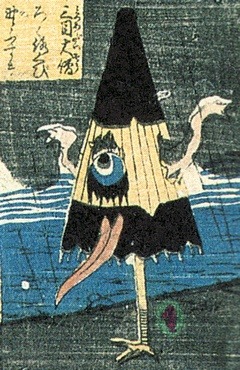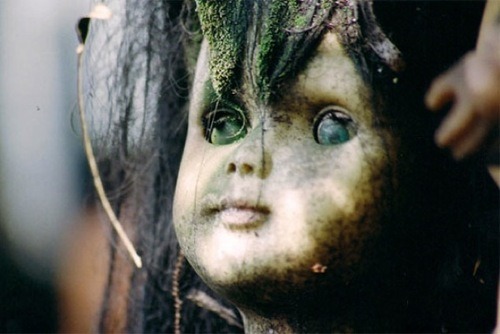
(via blueruins)
Modern Man, 1946, Bob Wilkins


Flexible honeycomb paper sculptures by Li hongbo - “flexible woman”
Beijing-based artist and designer li hongbo manipulates sheets of brown paper into sensuous three-dimensional sculpturesFlexible

Kasa Obake (傘お化け, “umbrella obake”), or Karakasa Obake (唐傘お化け?) or Karakasa Kozo (唐傘小僧), are a type of Tsukumogami, a folk legend about a form of Japanese spirit that originate from objects reaching their 100th year of existence, thus becoming animate. Karakasa in particular are Spirits of parasols (umbrellas) that reach the century milestone. They are typically portrayed with one eye, a long tongue protruding from an open mouth, and a single foot, generally wearing a geta.





Discarded Bottle Fish
One man’s junk is another man’s giant fish sculpture, so the saying goes (I’m sure somebody, somewhere, at some point said that). Set on the sunny Botafogo beach in Rio de Janeiro, this hugenormous light installation is constructed from illuminated discarded bottles, as part of the UN Conference on Sustainable Development. Check out some more shots at this flickr set by Ascom Riotur: flickr


Peter Burke.
After many years of using molds conventionally as negatives to be filled with materials, British artist Peter Burke became interested in the molds themselves. there is a curious relationship between the outside and inside of a mold, in their contained space they have a specific, dematerialized ghost form, and yet the outside which is generalized in form is more specific in its materiality. when confronted with a mold of the human form the viewer has an immediate association with and a curiosity about the nature of the space we occupy, and a predisposition to read the negative as a positive.
Well-known writer, part-time rapscallion and full-time great friend of us all here at Von Gutenberg, M. Christian sees not only the release of his new Welcome To Weirdsville from Renaissance E Books/PageTurner Editions but also a five part video series connected with it called Did You Know? (see it here) written Renaissance publisher Jean Marie Stine and produced by media master, Bill Mills.
Prolific scribe that he is (the guy has 400 stories published in anthologies alone!) we know M. Christian’s ability to not only turn a phrase but to unearth some of the most interesting tidbits on a subject, as he does in the non-fiction pieces he has penned for us and in WTW you’ll find more of the same as we learn about a noble Word War 1 German pirate, the City of Fire, the giggling genius of Brian G. Hughes, The Antikythera Device and much much more.
Knowing the diabolical naughty mind of M. Christian as we do there are also quite a few forays into things kinky in this book (read his excerpt about the Hellfire Club here)
Welcome To Weirdsville is a must for any student, devotes or those of us with a passing interest in marquis weirdness written about with unmatched aplomb.
You can check M. Christian out here: www.mchristian.com and get the book here.

"A wonderful compendium of interesting subjects and fascinating topics. Will keep you reading just to found out what's going to be covered next. Highly recommended for all lovers of weird & wonderful this side of the Universe." -Avi Abrams, Dark Roasted Blend.
Peek under the rugs, open more than a few drawers, peek in the back shelves and you'll find that ... well, Lord Byron himself said it best: "Truth is always strange, stranger than fiction." Lakes that explode, parasites that can literally change your mind, The New Motor, a noble Word War 1 German pirate, the odd nature of ducks, the War Magician, the City of Fire, men and their too big guns, a few misplaces nuclear weapons, an iceberg aircraft carrier, the sad death of Big Mary, the all-consuming hunger of the Bucklands, the giggling genius of Brian G. Hughes, the Kashasha laughter epidemic.... Ponder that in a world that holds things like kudzu, ophiocordyceps unilateralis, The Antikythera Device, The Yellow Kid, Leopold and Rudolf Blaschka, Alfred Jarry, Joseph Pujol, and suicide-bombing ants ... who knows what other kinds of wonders as well as horrors may be out there?
Welcome to Weirdsville
M. Christian
$9.99
PageTurner Editions
183 Pages
Available where all ebooks are found
Believe it or not, this awesome octopus isn’t a living creature. It’s an astonishingly beautiful object made entirely of glass by Leopold and Rudolf Blaschka, 19th century German glass artists renown for the production of biological models such as their Glass Flowers.
From Dark Roasted Blend:
Harvard Professor George Lincoln Goodale wanted examples to help teach botany, but the problem was plants have a tendency to … well, die. Sure, you could preserve some specimens but lots of species just don’t look the same after being dried – the plant version of stuffed and mounted. Yes, you could try using paintings or even photography but plants are – and here’s a surprise — three dimensional. So what Professor Goodale did was ask the Blaschkas to create detailed glass plants to help him teach his students about real ones.
What the Blaschkas did, was more than just recreate plants: they created astounding works of not only scientific accuracy but pure, brilliant, art. Even the simplest of their efforts is deceptively unencumbered… a sign of their genius as their reproductions don’t resemble the botanical model – they look EXACTLY like them, created by hand, in fickle and fragile glass, and all in the period 1887 to 1936.
This octopus deserves to stand on its own, but we recommend you visit Dark Roasted Blend to view more of Leopold and Rudolf’s exquisite glass specimens. Talk about awesome, we’ve never seen anything quite like them.
Peek under the rugs, open more than a few drawers, peek in the back shelves and you'll find that ... well, Lord Byron himself said it best: "Truth is always strange, stranger than fiction." Lakes that explode, parasites that can literally change your mind, The New Motor, a noble Word War 1 German pirate, the odd nature of ducks, the War Magician, the City of Fire, men and their too big guns, a few misplaced nuclear weapons, an iceberg aircraft carrier, the sad death of Big Mary, the all-consuming hunger of the Bucklands, the giggling genius of Brian G. Hughes, the Kashasha laughter epidemic.... Ponder that in a world that holds things like kudzu, ophiocordyceps unilateralis, The Antikythera Device, The Yellow Kid, Leopold and Rudolf Blaschka, Alfred Jarry, Joseph Pujol, and suicide-bombing ants ... who knows what other kinds of wonders as well as horrors may be out there?

As big fans of finger puppets, we were captivated by this awesome and unsettling sculpture as soon as we set eyes on it.
Entitled Monkey Mind, it was created in 2010 by artist Tip Toland using stoneware, porcelain, paint, and chalk pastel.
Visit Beautiful Decay to view more of Tip Toland’s incredible sculptures.